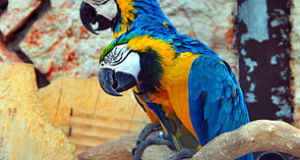As spring slowly makes its way across the Northern Hemisphere, aviculturists’ thoughts turn to nests and nestlings. Many birds, even those from tropical habitats, respond to the coming of spring by becoming increasingly active, hungry and interested in the opposite sex. While we often attribute this to longer days and warmer weather, this is only part of the story – the birds are more interested in the glut of new, nutritious food items that accompanies warm or rainy weather in nearly all habitats.
The Influence of Diet
One of the surest ways to bring your birds into breeding condition is to provide new, preferably natural types of food as spring arrives. I have found this to be true in every collection with which I have been involved. From hummingbirds to ostriches, novel foods bring results.
Most birds time their breeding to coincide with predictable increases in the availability of foods that will allow them to successfully raise their young. Budgerigars and others that inhabit harsh habitats may come into breeding readiness at the first hint of rain (and the promise of new plant growth), regardless of the season, but for the most part breeding is tied to specific seasons. Just as adding a nest box to a cage can cause some birds to begin courtship behavior, the provision of certain foods can be a breeding stimulus in and of itself.
Deciding What Foods to Offer
Read all you can about the natural history of the species in which you are interested, so that you can find out what types of food might become available during the breeding season in its natural habitat. Books and articles aimed at hobbyists will provide information concerning a healthy basic diet, but for specific dietary changes related to breeding you will likely need to consult field research reports published by ornithologists and students working in the field (or, of course, you can post a question on this blog!).
It is also useful to study the climate and weather patterns of your pet’s natural habitat – this may allow you to make an educated guess as to what foods to provide. You may not be able to provide the exact species of fruit or insect needed, but a close approximation may be enough.
Suggested Food Items
Following are some general ideas…please write in for information concerning specific birds:
Parrots: new types of fruits, flowers and seeds; Freeze-Dried Fruits may be useful in increasing dietary variety.
Finches, Softbills (i.e. Shama Thrushes, Pekin Robins) and Quails: Live and canned insects are invaluable in conditioning adults and raising chicks; also useful are hard boiled eggs, cottage cheese and Egg Food. Sprouts and chopped greens also signal “good times” to many species.
Hummingbirds and sunbirds are not the only species to feed upon nectar…a surprising number of birds consume it during the spring and summer. Lory Food is a useful alternative.
Once your birds hatch out their chicks, you’ll need to make other dietary changes. Nestlings require enormous amounts of food each day…a Zebra Finch was recorded as making 1,237 trips to the nest with food in a single day! More on that in a future article…until then, please write in with your questions and comments. Thanks, Frank Indiviglio.
Further Reading
Please see Live and Processed Insects for Pet Birds for other useful conditioning tips.
 That Bird Blog – Bird Care and History for Pet Birds
That Bird Blog – Bird Care and History for Pet Birds



